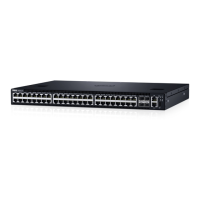• Conguring a Broadcast Address
• Congurations Using UDP Helper
• UDP Helper with Broadcast-All Addresses
• UDP Helper with Subnet Broadcast Addresses
• UDP Helper with Congured Broadcast Addresses
• UDP Helper with No Congured Broadcast Addresses
• Troubleshooting UDP Helper
IP Addresses
Dell Networking OS supports IP version 4 (as described in RFC 791), classful routing, and variable length subnet masks (VLSM).
With VLSM, you can congure one network with dierent masks. Supernetting, which increases the number of subnets, is also supported.
To subnet, you add a mask to the IP address to separate the network and host portions of the IP address.
At its most basic level, an IP address is 32-bits composed of network and host portions and represented in dotted decimal format. For
example, 00001010110101100101011110000011 is represented as 10.214.87.131.
For more information about IP addressing, refer to RFC 791, Internet Protocol.
Implementation Information
You can congure any IP address as a static route except IP addresses already assigned to interfaces.
NOTE
: Dell Networking OS supports 31-bit subnet masks (/31, or 255.255.255.254) as dened by RFC 3021. This feature allows
you to save two more IP addresses on point-to-point links than 30-bit masks. Dell Networking OS supports RFC 3021 with ARP.
NOTE: Even though Dell Networking OS listens to all ports, you can only use the ports starting from 35001 for IPv4 trac. Ports
starting from 0 to 35000 are reserved for internal use and you cannot use them for IPv4 trac.
Conguration Tasks for IP Addresses
The following describes the tasks associated with IP address conguration.
Conguration tasks for IP addresses includes:
• Assigning IP Addresses to an Interface (mandatory)
• Conguring Static Routes (optional)
• Congure Static Routes for the Management Interface (optional)
For a complete listing of all commands related to IP addressing, refer to the Dell Networking OS Command Line Interface Reference Guide.
Assigning IP Addresses to an Interface
Assign primary and secondary IP addresses to physical or logical (for example, [virtual local area network [VLAN] or port channel)
interfaces to enable IP communication between the system and hosts connected to that interface.
You can assign one primary address and up to 255 secondary IP addresses to each interface.
1 Enter the keyword interface then the type of interface and slot/port information.
CONFIGURATION mode
interface slot/port
• For a 1-GigabitEthernet interface, enter the keyword GigabitEthernet then the slot/port information.
• For a 10-Gigabit Ethernet interface, enter the keyword TenGigabitEthernet then the slot/port information.
IPv4 Routing
361

